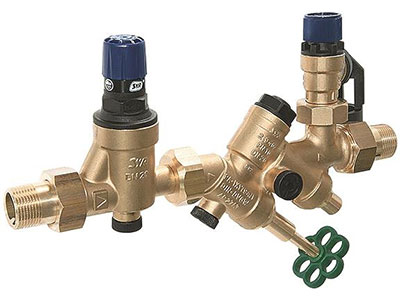What is a safety group?
- what is a safety group?
- how is a safety group constructed?
- what dangers arise in the case of a defect?
Every water tank has a safety group. But what exactly is it and how does it work? These questions and more about the safety group on a water heater we want to clarify in this article!

What is a safety group?
A safety group is the regulator for the pressure of a hot water tank. Water expands when heated, which causes increased pressure in a closed system such as the tank. In order to prevent this from leading to unwanted surprises, the safety group, with the help of a valve, drains water when the set pressure is exceeded. The use of such a component is required by law. If the safety group drips continuously, it should be replaced in any case. To avoid this, it is recommended to carry out an inspection once a year.
Structure
A safety group combines several components with different functions in one device. It is installed between the cold water network and the hot water storage tank. The unit should be as close as possible to the storage tank. Each safety group has at least one safety valve and one backflow preventer, but may also include other components.
Safety valve
If the set pressure in the storage tank is exceeded, the valve opens and allows excess water to drain. When the desired pressure is reached, the valve closes again.
Backflow preventer
If the safety valve opens, the backflow preventer stops the expanded and possibly contaminated water from flowing into the drinking water network. This prevents the contamination of the drinking water. However, water is always lost in the process, which can lead to increased costs if the safety group is used frequently.
Pressure reducer
The pressure reducer is usually already attached to the house connection and is therefore possibly not mandatory. It regulates the pressure in the drinking water network and thus prevents an already filled water storage tank from being loaded even more.
Pressure gauge
It allows to read the pressure in a reservoir. The manometer is usually built in and is available in several versions: as a nozzle or readable indicator with a needle.
Shut-off valves
They shut off individual components of the safety group, thus simplifying maintenance.
Expansion vessel
The expansion vessel is a separate chamber attached to the safety valve, into which the water causing the overpressure is directed before it is finally drained off. On the one hand, a buffer is formed which relieves the valve and, on the other hand, the excess water is not directly wasted, which in turn saves costs.
Dangers
As mentioned above, there is a certain pressure in any enclosed space. This pressure changes with temperature fluctuations. If the pressure in a hot water tank is too high, it can be damaged or even burst. Furthermore, hot water can leak from leaks and cause injuries. Therefore, check the functionality of your safety group regularly. However, you should only carry out the check yourself if you are familiar with the subject, because if there is damage, problems can arise with the insurance company if maintenance is not carried out properly.
Conclusion
A safety group should not be dispensed with under any circumstances. It prevents damage to the water tank, which can usually be far more expensive than the safety group itself. With the right device even water and thus additional money can be saved. In terms of price, safety groups start at 20€.


